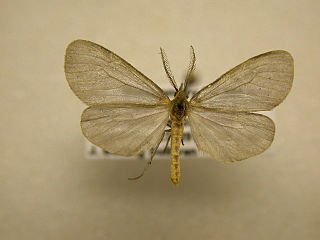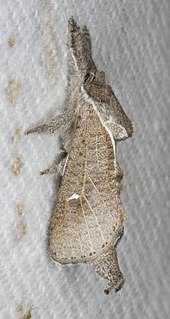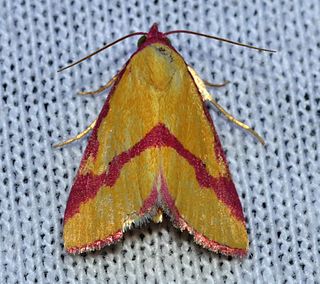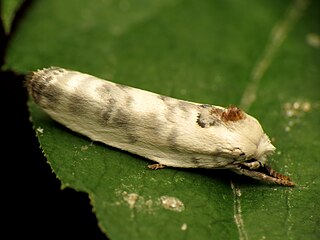
Pagara is a monotypic moth genus in the family Erebidae. Its only species, Pagara simplex, the mouse-colored lichen moth, is found in North America, where it has been recorded from Alabama, Arkansas, Florida, Georgia, Illinois, Indiana, Iowa, Kansas, Kentucky, Maryland, Mississippi, New Hampshire, North Carolina, Ohio, Oklahoma, South Carolina and Tennessee. Both the genus and species were described by Francis Walker in 1856.

Platynota rostrana, the omnivorous platynota moth, is a species of moth of the family Tortricidae. It is found from the United States, south through Mexico and Central America to South America. Its native range also includes the West Indies. It has been recorded from Europe, where it may temporarily establish through accidental importation in tropical plants.
Spilosoma latipennis, the pink-legged tiger moth, or the red-legged diacrisia, is a moth in the family Erebidae. It was described by Richard Harper Stretch in 1872. It is found in eastern North America, where it has been recorded from Georgia, Indiana, Iowa, Kansas, Kentucky, Maine, Maryland, New Brunswick, New York, North Carolina, Ohio, Ontario, Pennsylvania, South Carolina, West Virginia and Wisconsin.

Givira anna, the anna carpenterworm moth, is a moth in the family Cossidae. It is found in North America, where it has been recorded from Alabama, Arkansas, Florida, Georgia, Indiana, Kansas, Kentucky, Louisiana, Maryland, Mississippi, North Carolina, Oklahoma, South Carolina, Tennessee and Texas.

Microcrambus biguttellus, the gold-stripe grass-veneer, is a moth in the family Crambidae. It was described by William Trowbridge Merrifield Forbes in 1920. It is found in North America, where it has been recorded from Alabama, Florida, Georgia, Illinois, Indiana, Kentucky, Maine, Manitoba, Maryland, Massachusetts, Michigan, Minnesota, Mississippi, New Brunswick, New Jersey, New York, North Carolina, Nova Scotia, Ohio, Oklahoma, Ontario, Quebec, South Carolina, Tennessee, Texas, West Virginia and Wisconsin. It has also been recorded from Cuba and Puerto Rico.

Glaphyria cappsi is a moth in the family Crambidae. It is found in North America, where it has been recorded from Alabama, Florida, Georgia, Maryland, North Carolina, Oklahoma and South Carolina. It is also found in Cuba.

Nemapogon clematella, the barred white clothes moth, is a moth of the family Tineidae. It is found in most of Europe and in North America, where it has been recorded from Maryland and North Carolina. The habitat consists of woodlands.
Pyrausta insignitalis, the dark-banded pyrausta moth, is a moth in the family Crambidae. It was described by Achille Guenée in 1854. It is found in the United States, where it has been recorded from Florida and South Carolina. It is also found on the West Indies, as well as in Central and South America.
Carectocultus perstrialis, the reed-boring crambid moth, is a moth in the family Crambidae. It was described by Jacob Hübner in 1831. It is found in North America, where it has been recorded from Florida, Georgia, Maryland, Massachusetts, Mississippi, Nova Scotia, Ohio, South Carolina and Texas. Outside of the United States, it has also been recorded from the West Indies and South America.
Pseudogalleria inimicella, the inimical borer moth, is a moth in the family Tortricidae. It was described by Zeller in 1872. It is found in North America, where it has been recorded from Alabama, Arkansas, Florida, Georgia, Illinois, Indiana, Kentucky, Maine, Maryland, New Hampshire, North Carolina, Ohio, Oklahoma, Ontario, South Carolina, Tennessee, Texas and West Virginia.

Arogalea cristifasciella, the stripe-backed moth, is a moth of the family Gelechiidae. It is found in North America, where it has been recorded from Alabama, Arkansas, Connecticut, Florida, Georgia, Illinois, Indiana, Kansas, Kentucky, Louisiana, Maine, Maryland, Massachusetts, Michigan, Mississippi, Missouri, New Hampshire, New Jersey, New York, North Carolina, Ohio, Oklahoma, Ontario, Quebec, South Carolina, Tennessee, Texas, Virginia, West Virginia and Wisconsin.
Diasemiopsis leodocusalis is a moth in the family Crambidae. It was described by Francis Walker in 1859. It is found in North America, where it has been recorded from Alabama, Florida, Georgia, Oklahoma and South Carolina. It has also been recorded from the West Indies to South America.

Diastictis argyralis, the white-spotted orange moth, is a moth in the family Crambidae. It was described by Jacob Hübner in 1818. It is found in North America, where it has been recorded from Colorado, Florida, Georgia, Indiana, Maine, Maryland, Mississippi, North Carolina, Ohio, Ontario, South Carolina, Tennessee, Texas and Virginia.

Phytometra ernestinana, Ernestine's moth, is a species of moth of the family Erebidae. It is found in North America, where it has been recorded from Alabama, Arizona, Florida, Georgia, Illinois, Indiana, Iowa, Kansas, Louisiana, Michigan, Mississippi, New York, North Carolina, Ohio, Oklahoma, Ontario, South Carolina, Tennessee, Texas and Wisconsin. It is also present in Cuba.
Lygropia tripunctata, the sweetpotato leafroller, is a moth in the family Crambidae. It was described by Johan Christian Fabricius in 1794. It is found in the United States, where it has been recorded from Texas to South Carolina and Florida. It is also found from the West Indies and Central America to Brazil.
Palpita illibalis, the inkblot palpita moth, is a moth in the family Crambidae. It was described by Jacob Hübner in 1818. It is found in North America, where it has been recorded from Alabama, Florida, Georgia, Maryland, Mississippi, North Carolina, Ohio, Oklahoma, Pennsylvania, South Carolina, Tennessee, Virginia and West Virginia.

Antaeotricha albulella, the vestal moth, is a moth in the family Depressariidae. It was described by Francis Walker in 1864. It is found in the United States where it has been recorded from Alabama, Florida, Georgia, Louisiana, Maryland, Mississippi, New Jersey, North Carolina, Oklahoma, South Carolina, Texas and West Virginia.

Aroga compositella, the six-spotted aroga moth, is a moth of the family Gelechiidae. It is found in the United States, where it has been recorded from Alabama, Colorado, Florida, Georgia, Louisiana, Maine, Massachusetts, Mississippi, New Hampshire, North Carolina, Oklahoma, South Carolina, Tennessee, Texas and Wisconsin.
Coleotechnites canusella, the banded jack-pine needleminer moth, is a moth of the family Gelechiidae. It is found in North America, where it has been recorded from British Columbia, Washington, Alabama, Arizona, Louisiana, New Mexico and South Carolina.

Antaeotricha leucillana, the pale gray bird-dropping moth, is a moth in the family Depressariidae. It was described by Philipp Christoph Zeller in 1854. It is found in North America, where it has been recorded from New Hampshire, Massachusetts, New York, Pennsylvania, District of Columbia, Virginia, North Carolina, Georgia, Alabama, Arkansas, Missouri, Kansas, Illinois, Iowa, Texas, Oregon, Louisiana, Manitoba and Nova Scotia.












